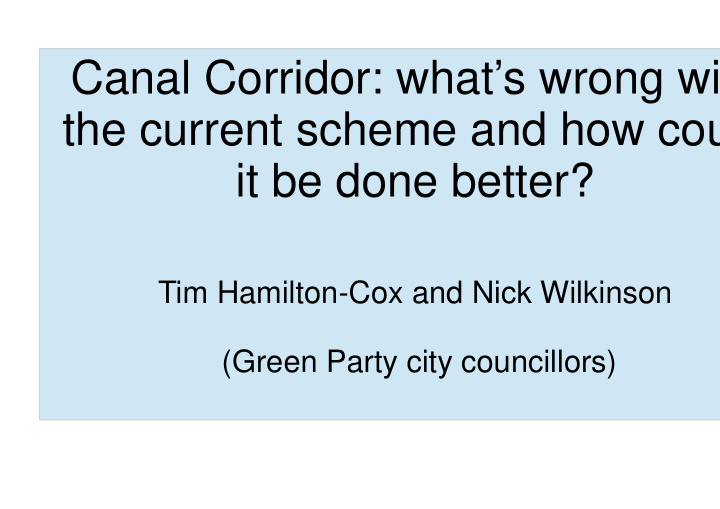



Canal Corridor: what’s wrong wi the current scheme and how cou ● it be done better? Tim Hamilton-Cox and Nick Wilkinson (Green Party city councillors)
17/03/18
Overview of the Canal Corridor Site Sugar House Canal Corridor boundary St Leonard’s Gate Lancaster canal e t e t r S g e d L o Brewery Lane Edward Street The Dukes Heron Chem. Works
Retail and Commercial 7.8 This area is relatively remote from the City Centre and the Primary Bus Corridor and has a residential emphasis. The Council would not wish to encourage retail, commercial leisure, food and drink uses and other uses likely to attract a lot of people
Wide Consultation Aimed at Finding Out What People Want for Brewery Site News Release: 23 November 2005 Centros Miller’s associate director, David Lewis, said: “We are delighted to have been appointed as the council’s preferred developer and having concluded a development agreement with Mitchell’s Brewery, we are now progressing the legal documentation with the council. At this stage we have no preconceptions about how the site might be developed and our consultation will start with the questions ‘what does Lancaster need?’ and ‘what would you like to see developed on the site?’ 17/03/18
I It's a bit grim up (the Canal Corridor) North
Place North W est 11 Dec 2017 NW in 2018: Bright future for Lancaster 'Working with British Land, we’re progressing proposals f the long-awaited Canal Corridor North development in Lancaster – a once-in-a-generation opportunity. This will the transformation and building of a new retail and leisur quarter for the city, which compliments the historic roma city and castle and helps magnify the cultural offer... ...A key partner... is Lancaster University, who also want great place with a special regional offer to complement t fantastic success of the university.'
Canal Corridor scheme outline ‐ as of 31 st October 2017 ● high street comparison (ie non ‐ food goods) retail floorspace ‐ 250,000 sq ft ● food and drink retail ‐ 70,000 sq ft ● 82 ‐ bedroom hotel ● 'arts hub' building which could house the Dukes, Ludus da and other arts organisations ● underground car park with 786 spaces ● student village in excess of 1,000 beds
Risky Business for Lancaster city council – and its tax ● Council land and property: loss of income ● Underwriting lease of arts hub ● Underwriting lease of underground car par ● Leases of 25/30 years ● Upward ‐ only rent reviews; no break clause ● And...
Still a big funding gap to fill
The potential upsides for Lancaster city counc ● Direct investment of £25m – borrowing £19.5m of it over 50 yea to generate 7% gross return “We would then use the income of that investment to offse risks associated with the arts hub.” ● Income from business rate growth
'The council recently received £300,000 in grant funding from Art Council England to work up propos and has also submitted a £4m capit funding bid to the Northern Cultura Regeneration Fund.'
Lancashire Northern Cultural Regeneration Fund Bids - In Assessment of Expressions of Interest A Report by Regeneris Consulting 6 November 2017 sulting ' Given the scale of the investment involved, (c.£34m) the direct economic impacts appear very modest (e.g. 39 jobs, £0.9 million GVA). References are made to the wider Corridor impacts which are very substantial, but not clear AHL [Arts Hub Lancaster] is essential to this larger impact realised.'
From Lancaster Guardian 07 ‐ 12 ‐ 2017: Council officers quoted: “British Land’s primary interest is long term return. They’re not a developer that has to make an immediate return. They’re interest in having a consistent return over 30 ‐ 40 yea So that is good because it ties them into the city in the long ‐ term.”
Warnings from (Lancaster city council's) history ● Mr Blobby ● Lancaster market ● Luneside East ● Need to avoid succumbing to optimism bias... or developer's hype ● But neither assume that always destined to repea
Lancaster market – a cautionary tale Cost of buying out the lease of Lancaster market was £13m happened because the City Council did not update and refre market as people’s retail habits changed. As a result the cou was left with an upward-only rent on a 99-year lease with no clauses. No business would have agreed to such a one-side deal. But Lancaster city council did and had to borrow more half its annual net budget to buy itself out of its obligations le than 20 years after the market opened 'amidst a blaze of pu and after the public had been told that after 'extensive comparative research', Lancaster market would be 'the very
● And then what's happening to retail....? ● “Online has been a catalyst that has reinforced the fact that we have many shops in the UK,” says Matthew Hopkinson, director at retail consultancy Local Data Company. “Around 10% of the UK retail stoc surplus to requirements, which equates to about 50,000 stores.” ● The retail workforce has shrunk from 3.2 million in 2008 to around 3 million today with the British Retail Consortium predicting another 900,000 jobs will disappear by 2025 as companies end their leases o unprofitable stores. ● That pace of job reduction has accelerated this year, with the BRC’s recent figures showing the biggest drop in hours worked and employment since it started keeping records in 2008, as the technological revolution in retail reduces demand for labour.
'2011. That was Preston’s year zero, when the grand schemes for the cit apart. For more than a decade the council had bet everything on a mass shopping mall. The Tithebarn would sprawl over the city centre, cost £70 be built by two of the biggest developers on the planet. It was going to ha Marks & Sparks, a multiplex and a huge John Lewis store. It was the lott said the council leader.'
Recommend
More recommend